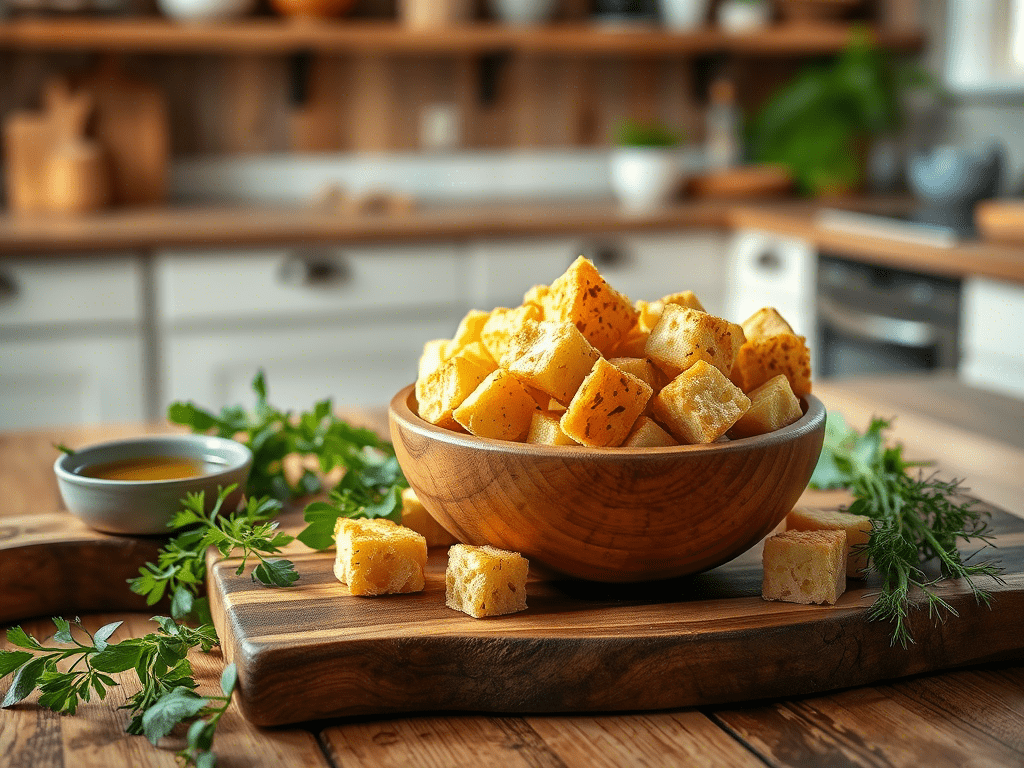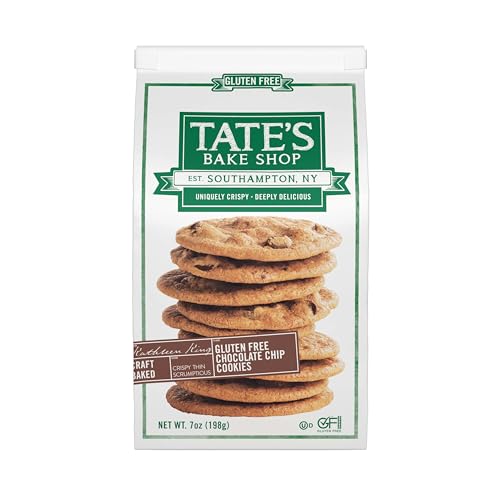5 Easy Gluten Free Croutons Recipes That Taste Better Than Store-Bought
Croutons might seem like a small detail in a salad or soup, but for anyone eating gluten free, they make a big difference. Whether you’re living with celiac disease, have a gluten intolerance, or are just avoiding gluten for health reasons, finding crunchy, flavorful, and safe croutons isn’t always easy.
That’s why learning to make your own gluten free croutons can be a game-changer. Not only do you get full control over the ingredients, but you also open up endless possibilities for flavor and texture. Store-bought options often fall short—either in taste, texture, or trust.
In this guide, we’ll walk through exactly what makes a crouton gluten free, how to avoid common ingredients that contain gluten, and share five delicious variations you can make at home. We’ll also show you the best breads to use, pairing ideas, storage tips, and even address common questions like: are corn flakes gluten free? or can cereals be used as coating alternatives?
If you’re ready to add satisfying crunch to your gluten free meals, this guide will show you how to do it right—easily, and with confidence.
Table of Contents
What Are Gluten Free Croutons?
Gluten free croutons are small, crispy bread cubes made entirely from gluten free bread. Unlike traditional croutons that often use white or wheat-based bread, these are made from alternatives like gluten free sourdough, multigrain, or even corn- or rice-based loaves.
What sets them apart isn’t just the bread—it’s also the preparation. Gluten free bread tends to be denser and less elastic than wheat bread, which means it toasts differently and needs slightly more attention when seasoning or baking.
To ensure your croutons are 100% gluten free:
- Use certified gluten free bread
- Avoid any seasoning mixes containing wheat flour or barley malt
- Check oils, dressings, or marinades for hidden gluten sources
Homemade gluten free croutons can be just as crunchy, flavorful, and versatile as the originals—if not better. With the right techniques, they’re perfect for topping soups, tossing in salads, or even snacking straight from the jar.
What Are Gluten Free Croutons?
Gluten free croutons are crispy, bite-sized bread cubes made from gluten free bread, perfect for adding texture and flavor to salads, soups, and even casseroles. Unlike traditional croutons that are made with wheat-based bread, these are crafted using certified gluten free alternatives like sourdough, whole grain, or rice-based loaves.
The main difference lies in the ingredients—and the precautions. While traditional croutons may contain wheat flour, malt, or other gluten-containing additives, gluten free versions eliminate all those risks. To ensure they’re truly safe, it’s important to choose bread that is specifically labeled “certified gluten free” and to avoid seasoning blends or oils that may contain hidden sources of gluten.
In addition to being safer, homemade gluten free croutons often taste better and are easier to customize. You can go light or heavy on seasoning, make them garlic-heavy, cheesy, or even spicy, depending on what you’re serving.
Whether you’re following a strict gluten free diet or just exploring better alternatives, learning to make gluten free croutons gives you full control over the taste, crunch, and quality—without the guesswork.
Ingredients to Avoid (Gluten Sneaks In Here)
When it comes to making or buying gluten free croutons, knowing what ingredients to avoid is just as important as knowing what to include. Many processed croutons—and even some seasoning mixes—contain hidden sources of gluten that can easily be overlooked if you’re not careful.
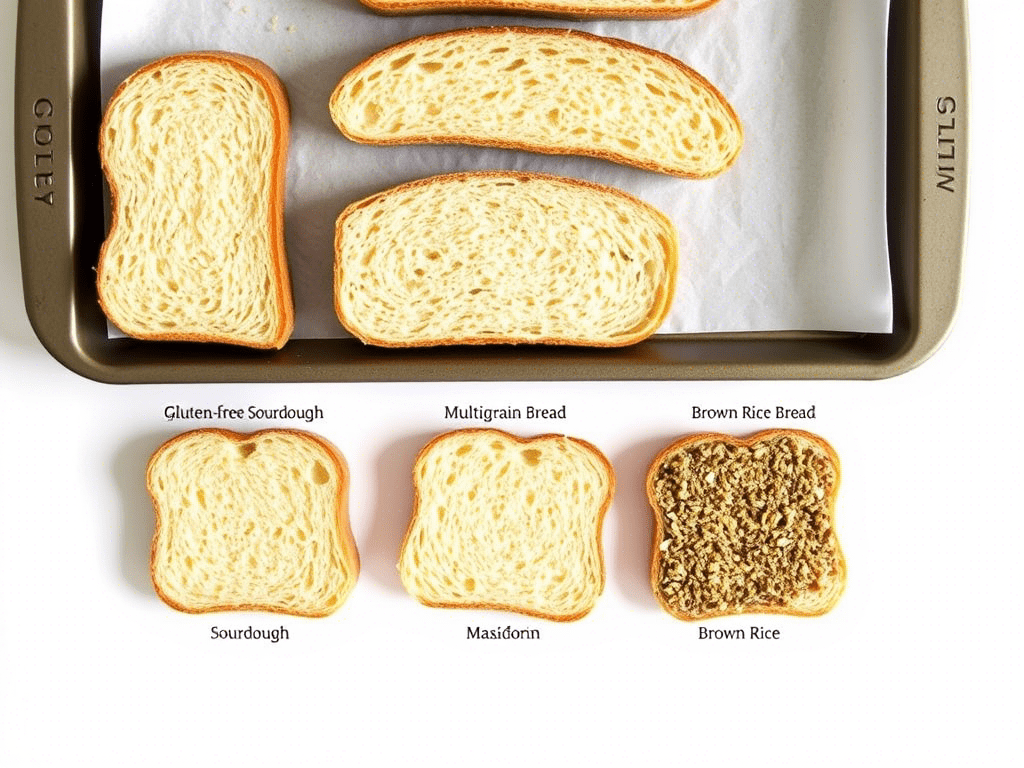
Common Gluten-Containing Ingredients:
- Wheat flour – The most obvious source, found in traditional bread.
- Barley malt – Often used for flavoring in commercial croutons and cereals.
- Modified food starch – Unless labeled as gluten free, it can be wheat-derived.
- Enriched flour or semolina – Common in cheaper crouton products.
- Hydrolyzed wheat protein – Sometimes used in seasoning packets or marinades.
These ingredients may seem minor, but they can trigger serious reactions in people with celiac disease or gluten sensitivity.
Hidden Sources to Watch For:
- Packaged salad kits – Croutons included in these kits are rarely gluten free.
- Seasoning blends – Garlic salt, spice rubs, or herb mixes may contain wheat flour as a binder.
- Oils or sprays – Some commercial sprays include wheat-based anti-foam agents.
You might wonder: are corn flakes gluten free? Some are—but others contain barley malt, which puts them off-limits. Always check labels carefully, especially when using cereals as a crunchy substitute.
Reading ingredients closely and sticking to trusted brands or homemade versions is the best way to ensure your croutons are safe, tasty, and truly gluten free.
Easy Homemade Gluten Free Croutons Recipe (Basic)
Making gluten free croutons at home is surprisingly easy—and the results are far better than anything you’ll find in a plastic bag. This basic recipe gives you a crisp, golden finish with simple ingredients and minimal effort.
Ingredients:
- 4 slices of certified gluten free bread (sourdough or multigrain work well)
- 2 tablespoons olive oil or melted butter
- 1/2 teaspoon garlic powder
- 1/2 teaspoon dried Italian herbs (oregano, basil, thyme)
- Pinch of sea salt
- Optional: grated Parmesan cheese or smoked paprika
Instructions:
- Preheat oven to 375°F (190°C) or prepare an air fryer.
- Cut bread into bite-sized cubes. Try to keep them uniform so they cook evenly.
- In a large bowl, toss the cubes with olive oil, garlic powder, herbs, and salt.
- Spread in a single layer on a baking sheet lined with parchment.
- Bake for 10–15 minutes, tossing halfway, until golden brown and crisp.
In air fryer: cook at 370°F for 6–8 minutes, shaking halfway. - Let them cool completely before storing.
These homemade croutons are crunchy, flavorful, and completely gluten free. Once you try them, you may never go back to store-bought again.
Flavor Variations You’ll Love
Once you’ve mastered the basic gluten free croutons recipe, it’s time to get creative. Changing up the flavor profile is easy and can take your croutons from simple to standout. Whether you want something bold for a tomato soup or subtle for a fresh salad, these variations will add personality to your plate.
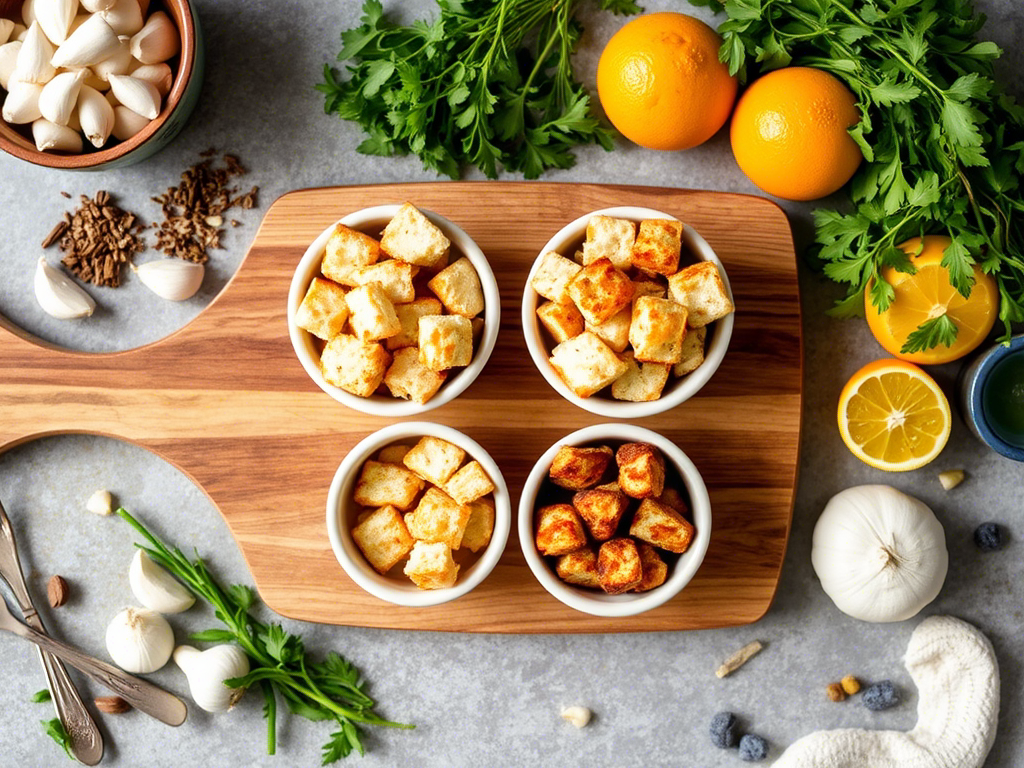
Garlic Parmesan
Add one tablespoon of grated Parmesan and a little extra garlic powder before baking. Let the cheese crisp slightly in the oven for a golden, savory finish.
Chili Lime
Toss the bread cubes with a dash of chili powder, a squeeze of lime juice, and olive oil. This variation pairs beautifully with taco salads or black bean soups.
Italian Herb
Double up on dried oregano, basil, and thyme. Add a sprinkle of onion powder for an extra layer of flavor. Works great with Caesar salads or pasta bakes.
Smoked Paprika & Sea Salt
For a smoky, slightly spicy flavor, use smoked paprika and coarse sea salt. Ideal for topping creamy soups like butternut squash or sweet potato.
Each of these seasoning styles can be made using the same base recipe. Just swap in your flavors of choice and keep an eye on the oven. The result? Custom croutons that match your mood—and your meal.
Best Gluten Free Breads for Croutons
The quality of your croutons starts with the bread. Not all gluten free breads toast the same way—some fall apart, others stay too soft. For the best texture and flavor, you’ll want to choose a bread that holds its shape, crisps nicely, and has enough density to handle seasoning and heat.
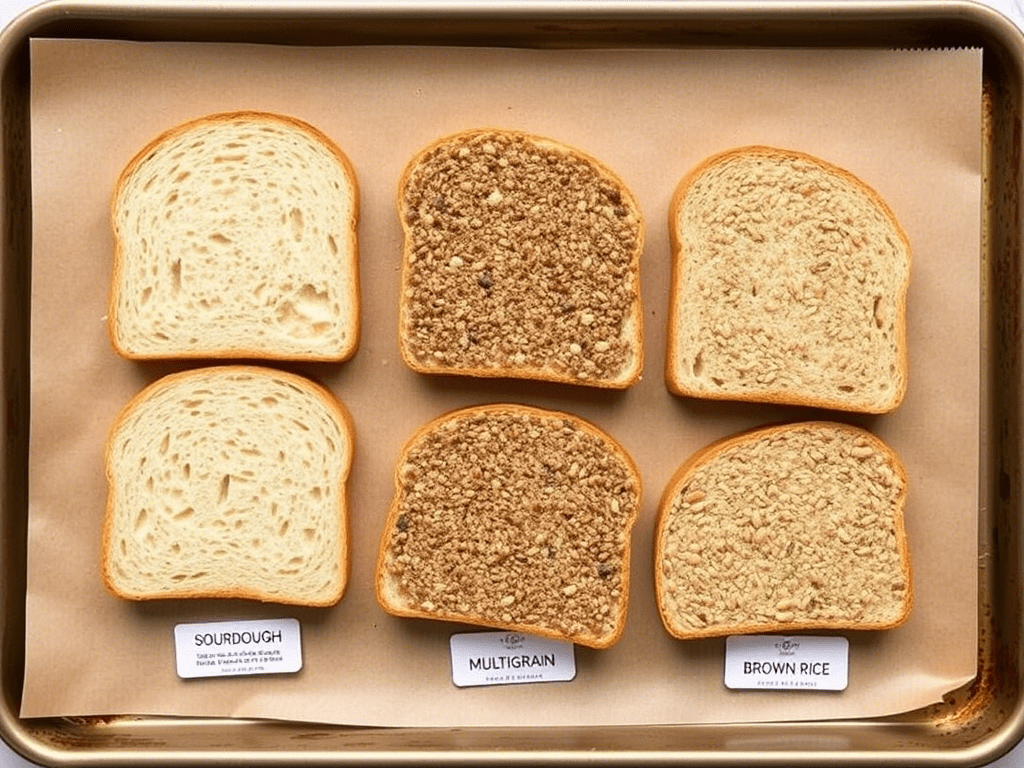
Here are some top options for making gluten free croutons at home:
Gluten Free Sourdough
Offers a firm structure and a tangy flavor. It crisps beautifully in the oven and adds depth to salads.
Multigrain Gluten Free Bread
Look for loaves with whole grains like millet, brown rice, or quinoa. These add fiber, flavor, and a slightly nutty taste.
Brown Rice Bread
Lighter and softer, but works well when cut into small cubes and toasted at a lower temperature to avoid burning.
Store-Bought Recommendations
Brands like Canyon Bakehouse, Schär, and Udi’s offer consistent texture and are widely available. Choose unsliced loaves if possible—they’re easier to cube evenly.
If you’re experimenting, you might also try crunchy toppings using gluten free cereal as a coating for salads or roasted veggies. It’s not a traditional crouton, but it works in a pinch and adds a satisfying crunch.
No matter which bread you choose, make sure it’s certified gluten free, and if possible, let it sit out for a few hours before cutting—it toasts better when it’s a bit dry.
Salad & Soup Pairing Ideas
Gluten free croutons aren’t just a topping—they’re a way to add texture, flavor, and character to your meals. Whether you’re upgrading a simple salad or finishing off a bowl of soup, the right croutons can transform your dish from average to memorable.
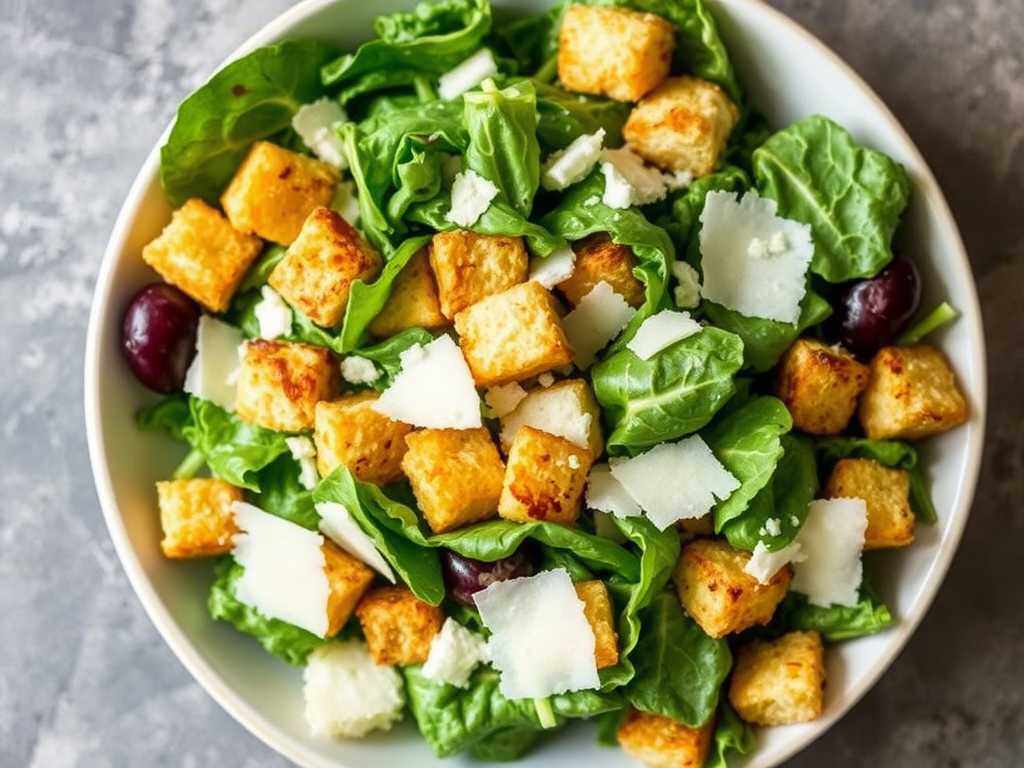
Classic Caesar Salad
Swap traditional croutons for homemade gluten free ones. Use garlic and herb-flavored croutons for the perfect bite with creamy dressing and crisp romaine.
Roasted Tomato Basil Soup
Crunchy croutons with Parmesan bring balance to a warm, savory soup. Add a drizzle of olive oil for an extra layer of flavor.
Butternut Squash or Carrot Ginger Soup
Pair with spiced croutons like smoked paprika or chili lime. The crunch adds contrast to these naturally smooth and sweet soups.
Mediterranean Chickpea Salad
Gluten free croutons seasoned with oregano and lemon zest work perfectly with olives, feta, and cucumbers.
Yogurt Bowls or Savory Parfaits
Yes, croutons can work with cold dishes too. Try adding lightly salted gluten free cereal or cinnamon-spiced croutons for crunch in yogurt-based dishes.
These pairing ideas show how flexible croutons can be—even when avoiding gluten. Just adjust the seasoning of your croutons to match the dish, and you’ll always have a balanced, satisfying meal.
Storage Tips & Shelf Life
Once you’ve made your perfect batch of gluten free croutons, keeping them fresh and crunchy is the next step. Unlike standard croutons, gluten free versions can soften or lose texture faster—so proper storage matters.
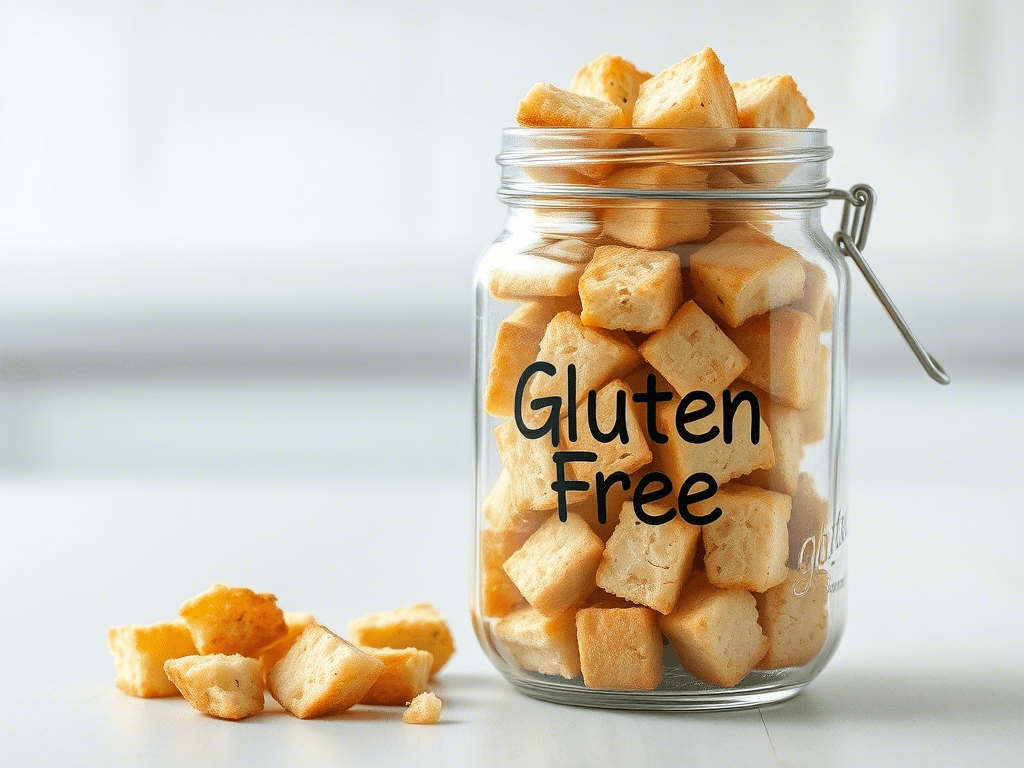
How to Store:
- Use an airtight container to prevent moisture from ruining the texture. Glass jars or BPA-free plastic containers work great.
- Store at room temperature in a cool, dry place away from heat or sunlight.
- For longer shelf life, freeze your croutons in a zip-lock bag. Just let them cool completely before freezing, and reheat briefly in the oven to bring back the crunch.
How Long Do They Last?
- At room temperature: up to 7–10 days
- In the freezer: up to 1–2 months
If you’re using gluten free cereal as a crunchy topping instead of bread-based croutons, the same storage rules apply—just make sure the cereal is sealed tightly and stays dry.
Wondering are corn flakes gluten free? Some are, but others contain barley malt. So if you’re thinking of using cereal as a crouton substitute, always check the label. Not all cereals are gluten free, even if they’re made from corn or rice.
Want to know what cereals are gluten free and safe for crouton-like crunch? Brands like Nature’s Path, One Degree, and Three Wishes make solid options that are certified and safe to use creatively in your kitchen.
Storing your toppings properly ensures your effort doesn’t go to waste—and that every bite remains flavorful and crisp.
Mistakes to Avoid
Even the best recipes for gluten free croutons can go sideways if you miss a few key details. Unlike traditional croutons, these need a bit more care to get the texture and flavor just right. Here are the most common mistakes—and how to avoid them.
Using the Wrong Bread
Not all gluten free cereal products or breads are created equal. Avoid using bread that’s too soft, gummy, or full of sugar. Look for sturdy, sliceable loaves that toast evenly.
Not Letting Bread Dry
Fresh bread can be too moist and result in soggy croutons. Let your bread sit out for a few hours before cubing, or lightly toast it first to remove moisture.
Over-seasoning
Gluten free bread absorbs flavor quickly. A heavy hand with spices can overwhelm the taste or make the croutons bitter when baked.
Skipping the Oil
Oil isn’t just for flavor—it helps your croutons get that crisp, golden finish. Whether using olive oil or butter, don’t skip this step.
Not Reading Labels
You might assume are corn flakes gluten free? or what cereals are gluten free? but assumptions can be risky. Some cereals contain barley malt or are made in facilities with cross-contamination. Always read the label before using cereal alternatives in your crouton recipe.
Taking time to prepare and double-check your ingredients will give you crunchy, flavorful gluten free croutons every time—without surprises.
FAQ – Gluten Free Croutons
Can I use store-bought gluten free bread to make croutons?
Yes, as long as the bread is certified gluten free. Look for brands with a firm texture that hold up during toasting, like Udi’s, Canyon Bakehouse, or Schär.
Are corn flakes gluten free, and can I use them instead of croutons?
Some corn flakes are gluten free, but many contain barley malt. If you want to use them as a crunchy topping, choose a certified gluten free brand. Always check the label.
What cereals are gluten free and work well as crouton alternatives?
Cereals like Nature’s Path Mesa Sunrise, Three Wishes, or One Degree Brown Rice Crisps can be great in salads or soups when you want crunch without bread. Just make sure the cereals are gluten free and unsweetened.
Can I make gluten free croutons in an air fryer?
Absolutely. They toast up beautifully in about 6–8 minutes at 370°F. Shake halfway through to ensure even crisping.
How do I keep my gluten free croutons from getting soft?
Let them cool completely after baking and store in an airtight container. You can also give them a quick toast before serving if they’ve softened slightly.
Final Thoughts + Internal Links + Amazon Picks
Making your own gluten free croutons is one of those small kitchen wins that delivers big results. Instead of relying on bland, overpriced store-bought options, you get to control the flavor, texture, and quality—right from your own oven or air fryer.
From understanding which breads to use, to mastering flavor combos and storing them the right way, this guide gave you all the tools to bring satisfying crunch to every salad or soup, without the gluten.
Whether you’re new to gluten free cooking or just want to step up your topping game, don’t forget to experiment, taste, and make it your own.
Internal Links
- Snow Cream Recipe – Fun & Easy Dessert
- Baby Shower Food Ideas That Guests Will Love
- Praline Pecans Recipe – Sweet & Crunchy Treat
Amazon Picks
- Canyon Bakehouse Gluten Free Bread – Great texture, perfect for toasting
- Olive Oil Spray Mister – Helps you coat croutons evenly
- Air Fryer Basket Liners – Makes cleanup easier
- Glass Storage Jars with Lids – Keeps your croutons crisp
- Gluten Free Garlic Herb Seasoning – Easy flavor upgrade
Making gluten free food doesn’t mean giving up flavor or texture. With the right ingredients and a little creativity, every meal can be just as exciting—and even better than before

